Croatia's April Sales of New Cars Plunge by 87%
ZAGREB, May 5, 2020 - Only 1,084 new passenger cars were sold in Croatia in April 2020, which is 87.4% fewer than in the same month in 2019, while 11,113 were sold since the start of the year, a decrease of 46.5% year on year, according to data provided by the Promocija Plus market research agency.
In the year to the end of April, Volkswagen (VW) was the best-selling car brand with 1,865 units sold, ahead of Skoda (1,674), Renault (739), Dacia (652) and Hyundai (555).
In April, the best-selling models were the Skoda Octavia (84 vehicles sold), the VW Golf (55), the VW T-Cross (32) and the Dacia Duster (32).
The low sales were due to the fact that all car dealerships were closed as part of restrictions imposed to stem the spread of the coronavirus pandemic.
In the first four months of 2020, 6,468 vehicles sold were powered by petrol, which is 58.2% of the total sales, 3,871 used diesel (34.8%), 75 were electric vehicles (0.7%) and 618 were hybrids (5.6%).
More economy news can be found in the Business section.
Milanović Discusses Post-Quake Reconstruction of Zagreb with HAZU Officials
ZAGREB, May 5, 2020 - President Zoran Milanović on Tuesday met with the leadership of the Croatian Academy of Sciences and Arts (HAZU) for talks on the reconstruction of Zagreb after a magnitude 5.5 earthquake struck the capital on March 22.
The HAZU delegation included President Velimir Neidhardt, Vice-Presidents Davor Miličić and Frano Parać and Secretary-General Dario Vretenar, according to a press release issued by Milanović's office.
Neidhardt presented a document in which HAZU presented their vision of the reconstruction of Zagreb after the March 22 earthquake, proposing a multidisciplinary approach that would take into account both public interest and the common good, as well as excellence.
The academicians also informed the President of the Republic of the damage done to the HAZU buildings and the plans for their reconstruction.
More earthquake news can be found in the Lifestyle section.
Zagreb Summit to Confirm European Perspective of Western Balkan Countries
ZAGREB, May 5, 2020 - The European perspective, the commitment of the Western Balkan countries to the European Union and cooperation in the coronavirus crisis are the key elements of a declaration that will be adopted at the central event of the Croatian EU presidency in Zagreb on Wednesday, Foreign Minister Gordan Grlić Radman said on Tuesday.
On the initiative of the Croatian Presidency of the Council of the European Union, the summit of the 27 EU member states and the six Western Balkan countries, scheduled for May 6, will be held online in light of the coronavirus pandemic.
"Cooperation in dealing with the pandemic, giving the Western Balkan countries the European perspective and these countries' commitment to European values" are the key elements of the Zagreb Declaration, Grlić Radman told the press outside the government offices.
He recalled that North Macedonia and Albania had been given the green light on their path to EU membership which he said was "a great Croatian success".
Zagreb will again host a summit on the European perspective of Southeast Europe, just as it did 20 years ago when Croatia was not yet a member of the EU. The next summit was held in Thessaloniki in 2003 and the last one took place two years ago in Sofia.
The Croatian EU Presidency has proposed that summits on European integration be held every two years, Grlić Radman said.
"Not all EU members are equally interested in enlargement. There is still talk of what the future will bring with new members, but Croatia has shown the initiative in this regard," he said.
More news about Croatia and the Western Balkans can be found in the Politics section.
Zadar's Tourism Apparatus Returns to Form in Coronavirus Era
May 5, 2020 — Zadar waits. While Croatia’s Tourism Ministry and industry groups around the country try to salvage a summer season wrecked by the COVID-19 pandemic, Zadar waits.
“It is clear that health is an absolute priority. We all hope the stabilization of the epidemiological situation and the opening of markets and economy will facilitate the implementation of the summer part of this year's tourist season,” Zadar Tourist Board Director Mario Paleka told Zadarski List.
“Although it is thankless to predict anything because we live and function in unprecedented experimental conditions, there are indications that a more free flow of people and goods across borders can occur, which, with competitive measures and business conditions for tourism, hospitality, and other complementary businesses, is sure to result in some tourist traffic this summer.”
Paleka, a kinesiologist and the town’s former Sports Director, says the Tourist Board is coordinating with all interested parties to devise some plan.
In late February, Paleka suggested the coronavirus may only affect the shoulder season. His colleagues in Dubrovnik said the same.
But since then, the “Pearl of the Adriatic” launched an ad campaign and asked the government to grant it special status to allow for charter flights and private jets. Whether it will pass doesn’t matter much — its tourism machine continues to hum along and spitball ideas, staying visible while Minister Gari Cappelli seeks a way out of the COVID-19 mess.
Zadar, meanwhile, waits.
The coastal town perpetually rests atop Croatia’s “Next Big Thing” travel list — a bonanza of potential scattered across a peninsula, hinterlands, and islands book-ended by three national parks — Kornati, Paklenica, and Plitvice. Yet Zadar never earns the notoriety or reach of mythic Dubrovnik or vibrant Split. It just waits.
It won the European Best Destination in 2016, giving it a publicity boom. Zadar welcomed the pick. Then did nothing.
Last year, Zadar earned a coveted spot on The New York Times’s 52 Places but did little with the distinction. Unless you count a disastrous Rita Ora concert which blew a reported €100,000 hole through the town's budget.
It also did nothing while neighboring destinations took leaps forward.
Rijeka’s turn as the European Capital of Culture created a flurry of attention.
Šibenik’s under-reported rejuvenation puts an emerging attraction about 30 minutes away from Zadar.
The town’s robust ferry port, cruise ship terminal, and regular low-cost airline arrivals brought record numbers of tourists with little desire to stay. Most took in the two days’-worth of sights and hightailed off, often south or inland to Plitvice.
Its connectedness — a strength in the hands of any other city — leaves Zadar in danger of becoming a weigh station for travelers on their way to somewhere (anywhere) else on the Dalmatian coast.
This year, like many before it, was supposed to be better. Not in any specific way. The summer calendar of events was shaping up to be a copy-paste of last year’s.
Then a pandemic broke out.
The tourism ministry suggested a summer season saved by Croatians themselves. But Tomislav Fain, President of the Association of Croatian Travel Agencies, dismissed the idea.
“A number of citizens have their own holiday homes and holiday cottages,” he told Zadarski List. “They are also guests, but they have their own accommodation. There will be empty apartments, they will go to their friends for free. I would first receive my friend from Zagreb in an empty apartment.”
Croats make up only 12 percent of Zadar’s annual tourism haul, according to the town’s Tourist Board. Fain wondered how a country with a dilapidated economy and mass unemployment can count on its own people.
And so it dismisses the notion of luring more Croats. Instead, Zadar waits.
Finally, an idea from Daniel Radeta, from the Zadar Private Accommodation Owners Association: lower prices.
“It is important to lower the prices of highways and even shipping lines,” he said. “Renters, caterers, all have to lower prices, but it is important above all that they are accompanied by the state and which reduces taxes.”
And so Zadar waits. It waits for lower taxes, lower tolls, and… a plan.
Analysis: Coronavirus in Croatia Compared to Other European Countries — May 5 Update
May 5, 2020 — A graph showing the number of deaths from or with the SARS-CoV-2 virus per million population per country places Croatia among the five best-ranked countries with the lowest proportional death toll, according to the Johns Hopkins University Coronavirus Database.
In addition to Croatia, there are Greece, Poland, Bulgaria and - according to the available data - Slovakia. The next low mortality group includes the Czech Republic, Hungary, Finland, Romania, Estonia, Norway, and Slovenia, with the worst situation affecting Belgium, Spain, Italy, and France.
Compared to Croatia, often due to its access to epidemic measures, oft-mentioned Sweden has a death toll of around 14 times per million. Belgium has as many as 35 times more casualties per million inhabitants.
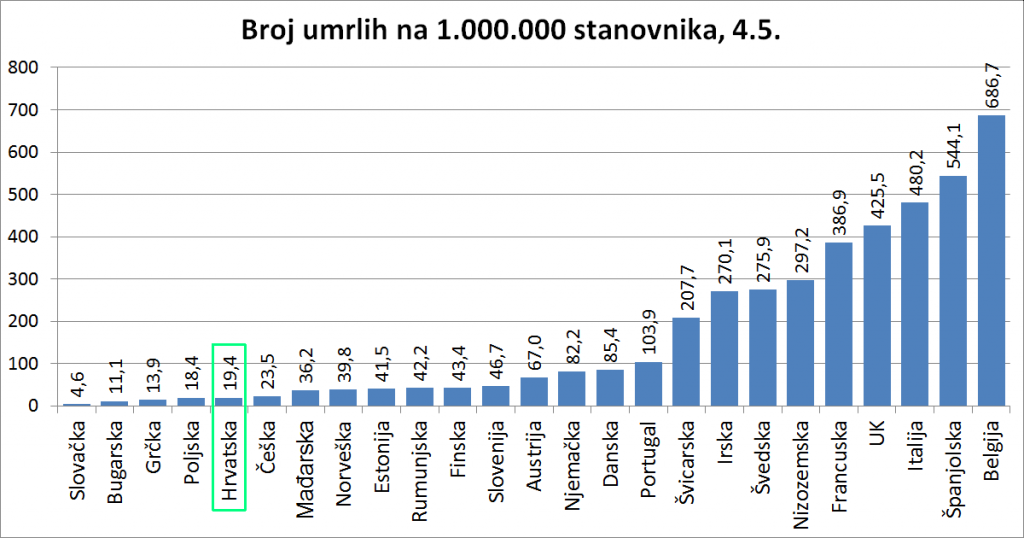
Specifying only the absolute numbers of registered infected persons or persons who died from or with the presence of a new coronavirus per country does not give a true picture of the situation, given that there are huge differences in the populations of individual states.
For example, Belgium with its 11.5 million inhabitants has so far had 7,924 casualties, while Italy with 60.5 million inhabitants has 29,079 casualties, but Belgium has as much as 43% more casualties per million inhabitants than Italy.
It can also be said that Germany with 6,866 deaths has far more casualties than Sweden with 2,769, and in fact, per million inhabitants Germany has 70% fewer casualties than Sweden.
When looking at the number of infected persons and their outcomes starting on the same day, regardless of the outbreak of the epidemic in each country, as shown in the following figure, it is difficult to compare the epidemic development by country in parallel. The slope of a single curve over a period indicates the rate of spread of the epidemic, as far as can be determined by confirmed infections. We do not know the number of undiagnosed infected people.
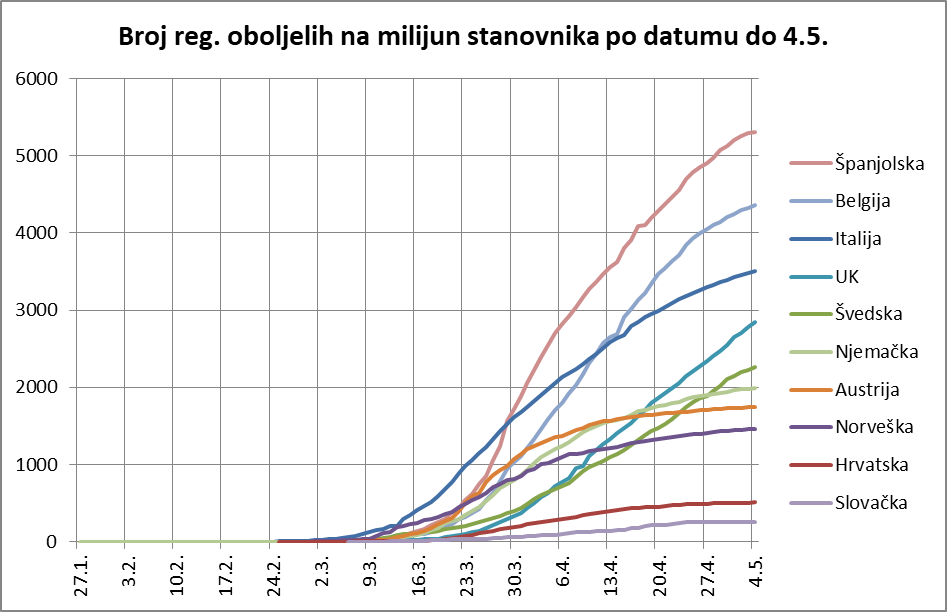
It can be seen that among the observed countries, the epidemic first flared up in Italy. However, the increase in the number of patients in Spain (about a week later) was much faster than in Italy, and the number of people in Italy had increased by one million people by the end of March.
Spain has the highest number of patients per million people in the countries, and the curve is just beginning to show a significant reduction.
The second-fastest growing epidemic is Belgium, with a slightly lower growth rate than Spain, also with indications the virus’s spread is slowing in the past week.
Italy, the third-most infected country in terms of numbers per million people, has been showing signs of slowing down over the past two weeks.
The next two countries that currently have linear curves with no signs of slowing down are the United Kingdom and Sweden. Sweden exceeded the number of registered patients per million inhabitants in Germany in early May, and their own research indicates the likelihood of a large proportion of residents infected but not diagnosed.
Slovakia and Croatia have controlled the epidemic well from the outset, and Austria, Norway, and Germany have been able to successfully cope with the rapid growth that occurred around the week of March 23-30.
The following chart provides an overview that begins for each country from the date the infected person was first registered in that country. In this way, it is possible to compare the development and effects of epidemic suppression both in dynamics and in relative numbers per million population.
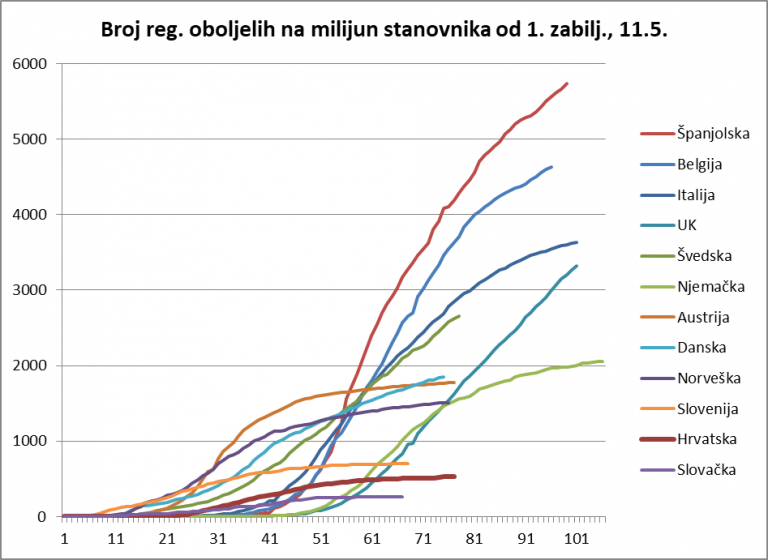
At first glance, two groups stand out from the countries observed. The left group is one in which the epidemic developed relatively quickly after the first diagnosed person in terms of population: Austria, Norway, Denmark, Sweden, Croatia, and Slovakia. Of course, these are smaller countries. The right group is one in which more time has elapsed since the emergence of the first infected person (that is, the first infected person was diagnosed much earlier) and they are in the order of the state with a larger population.
In the first group, there was a rapid increase in the number of people infected in Austria, but also a very rapid response that reversed the epidemic as early as the 32nd day, and even without "leveling", a consistent reduction in the number of new infections was immediately achieved.
The epidemic has calmed down after about 50 days in that country, which of course has a great impact on deciding what to do next. The rate of increase in the number of people infected since week 51 is actually the same as in Croatia, except that there are significantly fewer patients in Croatia.
There is a similar course to the epidemic in Norway, with an even sharper start, but apparently a swift response from the authorities, who reversed the trend around day 32 as well, and contained the epidemic around day 45.
In Denmark, the epidemic started very much like in Norway, with the first calming down even faster, but after that linear growth continued at a rate higher than in Austria and Norway.
The same group is followed by Sweden, which initially did not have rapid growth, but around the 55th day grew in the number of registered infected persons Denmark, Norway, and Austria, and around the 66th day also Germany, and does not see any calm.
Viewed from this chart, Croatia and Slovakia maintain a very low slope linear curve from the very beginning and have the lowest number of registered infected persons per million inhabitants.
The group of larger countries shows that the worst situation is in Spain, which after exponential growth until the 56th day of the epidemic in its territory, was able to achieve linear growth in its curve, and then from around the 62nd day a slightly milder but still large slope. Within a few days, it could be felt that the epidemic was beginning to subside.
It is similar in Belgium, which flattened the curve around day 54, but has since maintained a steady but high (relative) increase in new infections with signs of calming back for several days.
Italy, whose exponential curve started about a week before the one in Spain, reached a more moderate slope of the linear part of the curve around day 49 and shows a slight calming of the epidemic after about 81 days.
Germany, with some time lag compared to the first registered infected person, achieved a curve similar to Austria, with a trend change around day 68. But its rate of increase in the number of infected in the back of the curve is still higher than in Austria.
After exponential growth, the UK was able to straighten the curve around day 70, but with no indication of stabilization.
Looking more closely at Sweden, we can see a form of exponential growth in the number of infected people that has turned linear over the last three weeks.
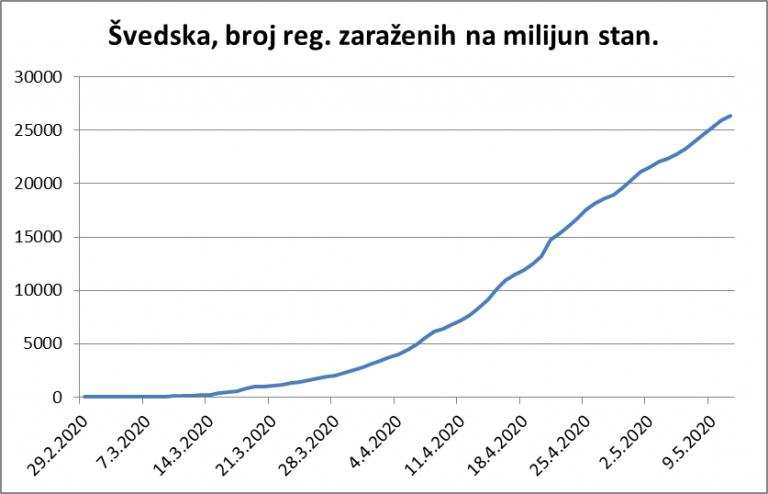
If we take a closer look at Croatia, we will see that linear growth has already been achieved around March 22 (just after the earthquake in Zagreb), and from April 16 is very successful in calming the epidemic. It could also be statistically concluded that the average healing time for registered patients is between three and three-and-a-half weeks.
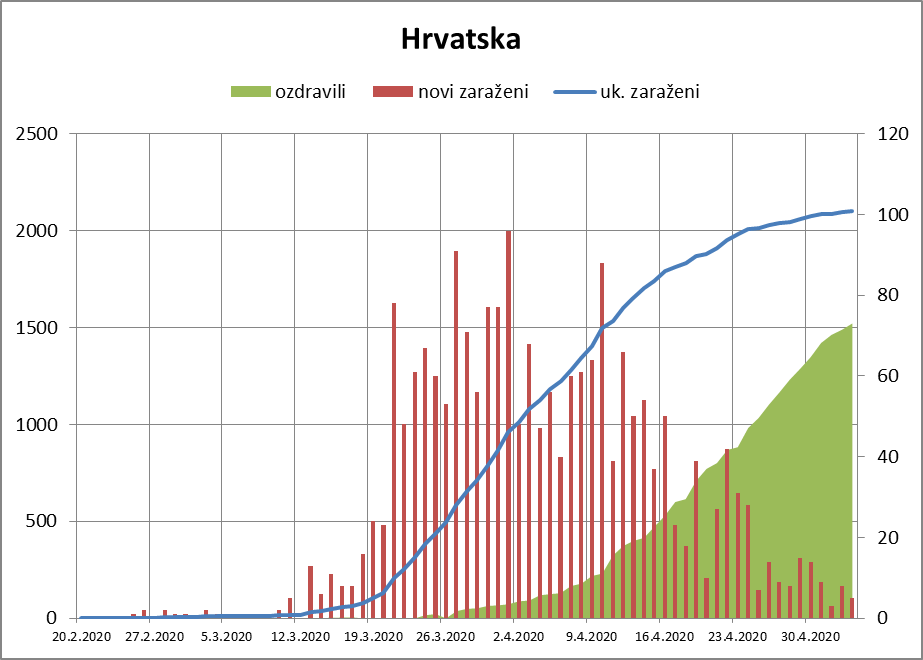
Croatia's excellent result can also be seen in the chart showing the trend in the number of sick and dead.
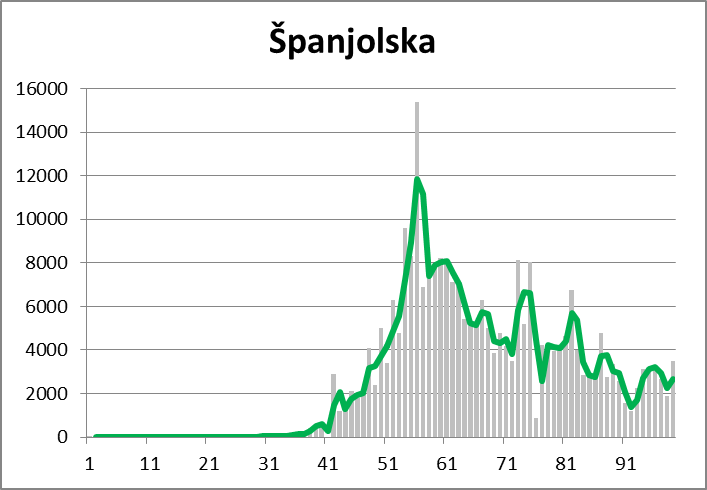
These topics often raise the question of what is a good test measure and whether we are testing enough. An excellent graphical representation of the testing ratio per million population and the percentage of positives shows who optimally tests and who does not. If you are about 10% positive you have found a good measure - Croatia is.
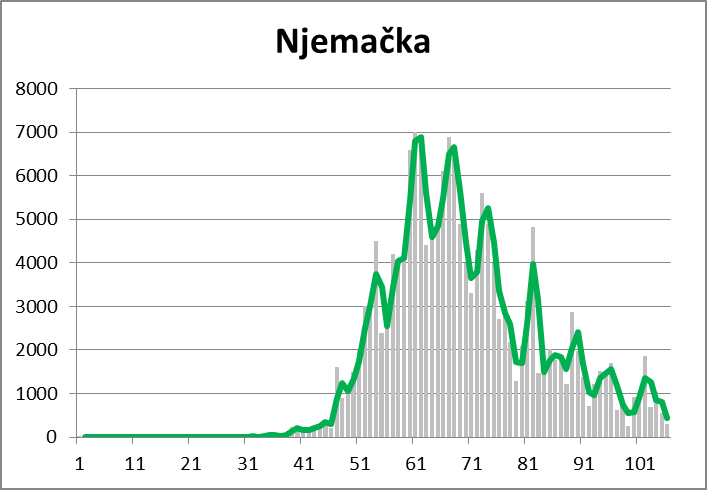
It can be concluded that the epidemiologists were in excellent control of the epidemic and that the Civil Protection Directorate made successful recommendations and measures to mitigate it.
Scientific knowledge, in comparison to the usual political ones, is neither conservative nor radical; they are simply as they are and should be trusted. And so others reasonably rank Croatia among the countries that successfully defeated the coronavirus.
Given that crisis management decisions, especially in the phase of loosening anti-epidemiological measures, are not exclusively health but equally political, further careful monitoring of the situation and comparison with policy decisions and health outcomes in other countries is needed.
Of course, every country can be asked what its long-term perspective is in these new circumstances that will not go away.
Countries that have curbed the epidemic in the sense that they have ensured that their health care system can control the situation, may be far more comfortable developing a further strategy than those who still have to put all their efforts into maintaining the health system's functionality.
And finally - is coronavirus more dangerous than the flu? Yes, but as far as we may know, in just a few months, we are learning something new every day. The important difference is that the behavior of SARS-CoV-2 is still a great unknown and that we do not have vaccines or reliable treatment for severe forms of COVID-19.
HAMAG BICRO Receives 2237 Loan Applications from Business Owners
HAMAG BICRO has received a large amount of applications from Croatian business owners across the spectrum for loans. These enterprises have made their applications due to the fact that they have been financially hit by the coronavirus pandemic and the economic crisis that has emerged from that.
As Novac writes on the 5th of May, 2020, the Croatian Employers' Association and the Croatian Agency for Small Business, Innovation and Investment organised a webinar with the aim of clarifying the measures in place to preserve the liquidity of small and medium Croatian companies.
Croatia's business owners have now been being offered various working capital loans for over a month, these include the ESIF Mirko working capital loan, the COVID 19 working capital loan and the micro working capital loan for rural development.
Representatives of HAMAG BICRO, Iva Debanic and Josipa Kutle Stepancic, explained the dynamics of receiving and processing these applications:
''To date, a total of 2237 applications have been received by HAMG BICRO for these three loans and 445 have been processed with an average approval rate of 70 percent. Looking at the figures, it's important to understand that the higher pass rate of applications for the COVID loan is associated with a larger number of eligible activities, ie, applications from ineligible activities created more negative ratings for other loans. When we talk about these loans, it's important to know that the aid currently being granted is de minimis aid. Aware that the prescribed limit of a maximum of 200,000 euros per business owner over a three-year period is a restriction for some, HAMAG BICRO is in the process of drafting a new set of rules on state aid that is better adapted to the current market situation and the effects of the coronavirus pandemic on the economy.
In several loan applications, there were requests for the financing of fixed assets (investments in equipment or adaptations), but this is not allowed via these financial instruments. It's also not possible to refinance existing liabilities, such as closing leases, existing loans and such things. For COVID loans, VAT is an eligible cost, while for the remaining two micro loans, it isn't (for PRR loans, the cost is eligible if the applicant is not in the VAT system).
In the case of the ESIF microloan and the microloan for rural development, a significant difference in relation to the COVID loan is the ineligibility of medium-sized entities. Furthermore, the grace period, which was previously up to 6 months for the ESIF microloan, has been extended to 12 months. Upon approval, the funds are paid into a special purpose account and used for a period of 3 months for micro loans or up to 6 months for COVID loans. For all of these loans, it should be noted that when they're approved, the average quarterly or six-month amount of regular (working) expenses is analysed, and the loan amount is then approved accordingly.
With the funds for micro loans, it's possible to settle obligations that are up to 3 months old from the date of the receipt of the loan application, while with COVID loans, all costs incurred throughout 2020 are eligible. However, it may not be used to pay bills already paid or for investments used for private purposes.
In recent days, a large number of inquiries from Croatian business owners have arrived at both HUP and HAMAG BICRO's doors regarding the new obligation to register on the FINA portal, so, the most common doubts and questions were clarified:
- All applications for HAMAG BICRO loans must come directly to them together with all of the prescribed and required documentation
- Registration on the FINA portal is mandatory but represents an additional step and cannot replace direct application
- Registration on the FINA portal replaces the need to submit a HROK credit report because FINA submits this information on the business owner, which includes the Croatian National Bank's assessment on any existing debts
- When assessing the acceptability of a loan application, the business plan and the accompanying financial indicators of the business in question are fuly taken into account, and not only the ''COVID score'' created on the FINA portal
- The FINA portal does not allow for the reporting/registering and proving of the loss of future income (in the second quarter of 2020) but this does not affect the passability of the request because the same is proven directly in the report to HAMAG BICRO
After approving the funds, the user/business owner must then open a special purpose account. All payments must be made directly from that account to the supplier’s account and must never be paid in cash. In the case of the need to pay salaries, on the day of the payment of salaries, part of the money may be transferred to a basic account and later on through statements, the business owner can prove to HAMAG BICRO that the funds were indeed spent for the intended purpose (on the payment of employee salaries).
This business plan defines the regular monthly expenses and is therefore classed as an eligible expense. What is important to note is that if the monthly agreed payment is for rent, you cannot pay it outside the agreed terms of use (for example, the annual rent cannot be paid). However, if the business owner has a previously agreed annual payment of rent that is due at the time of using the loan, then the same is acceptable.
In the case of an ESFI loan, when paying a VAT invoice, the company pays the VAT cost from the regular invoice and then pays the full amount of the invoice to the supplier.
Financing the salaries of the beneficiaries of the Croatian Employment Service's measure for the preservation of jobs doesn't pose an obstacle for the beneficiaries of HAMAG BICRO loans to finance everything above the amount of received support (if the employee's salary is higher than 4000 kuna) or to finance the salaries of employees not covered by the aforementioned institution's measures in order to avoid double financing.
Regarding the dynamics of the processing of these requests, it's worth understanding that more requests were received in just one single month than were received during the whole of 2019.
At the beginning, a large number of requests were received without any supporting documentation, which was tolerated at the time owing to panic and a general lack of understanding, but this additionally burdens the already stretched evaluation resources which are working to resolve backlogs.
In order to work as efficiently as possible, the appeal is for the complete submission of all required documentation because then the processing procedure is faster and more smooth.
The materials from today's webinar will be published on the HUP website, and in a few days, a consolidated document with the received questions and answers will be published so that as many business owners as possible receive the necessary clarifications to their questions and confusion.
Follow our business page for more. Stay up to date with our dedicated section for all you need to know about coronavirus in Croatia.
With Croatia's Hair Salons Open, How is Business? The View from Durdevac
May 5, 2020 - Croatia's hair salons are open once more, albeit with strict social distancing. So how busy are they? The view from Durdevac.
Week 2 of the gradual easing of some measures saw the opening of hair salons once more in Croatia. But in the corona era, things were hardly as they once were, and social distancing and hygiene regulations means that the hair salon experience - for now at least - is a lot less social than it used to be.
So how is the new reality, and how busy are hair salons? There must surely be a lot of people waiting to have their hair done after weeks of self-isolation. Am very grateful to Joubert Loots, a South African photography married to a Croatian wife up in Durdevac for sending me these photos and a little explanation of how the situation is in Durdevac.
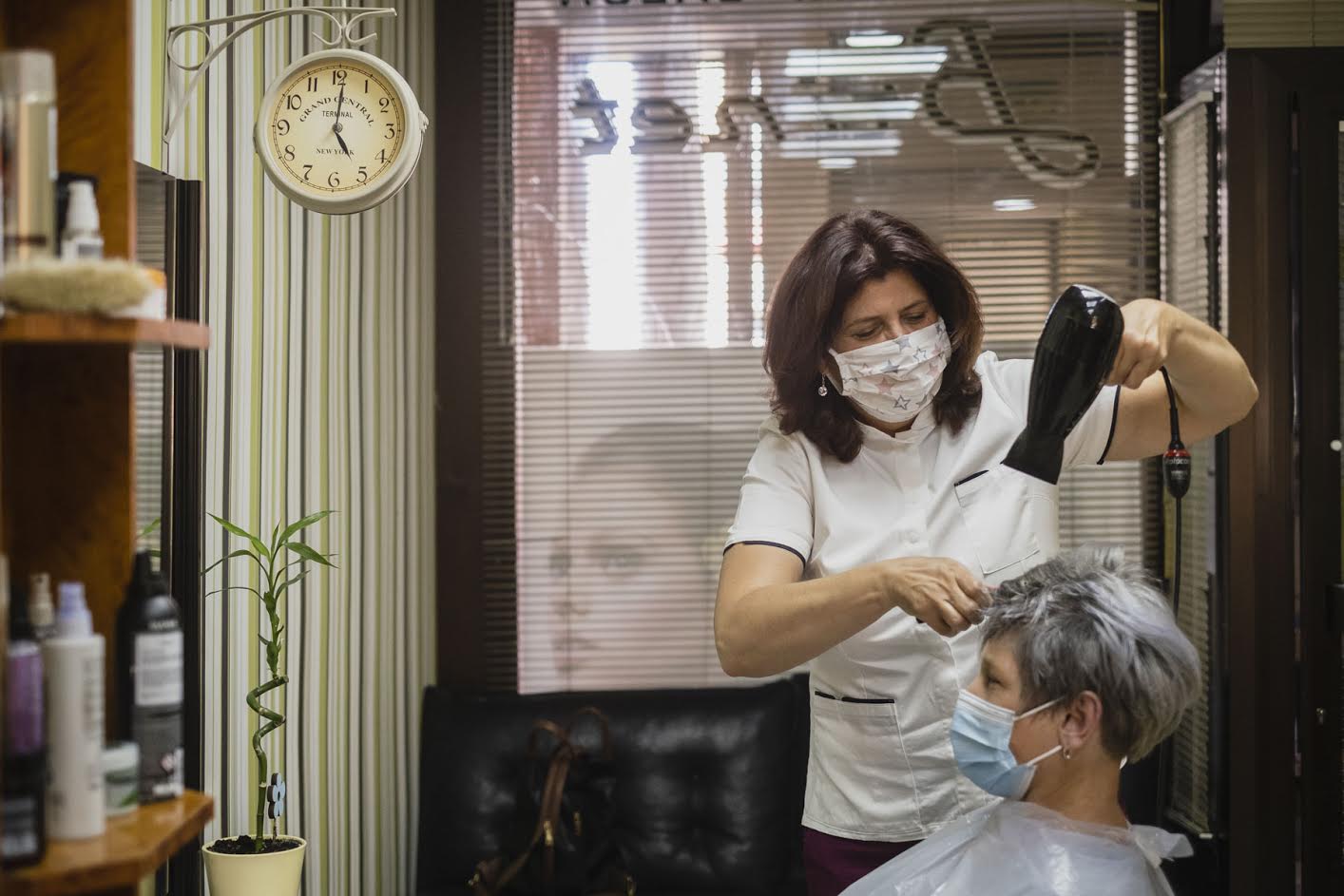
Joubert documented local hairdresser Anita Raknitican on her first day back serving customers. Due to the new rules, only one hairdresser is allowed to operate in the salon, and only one customer at any given moment.
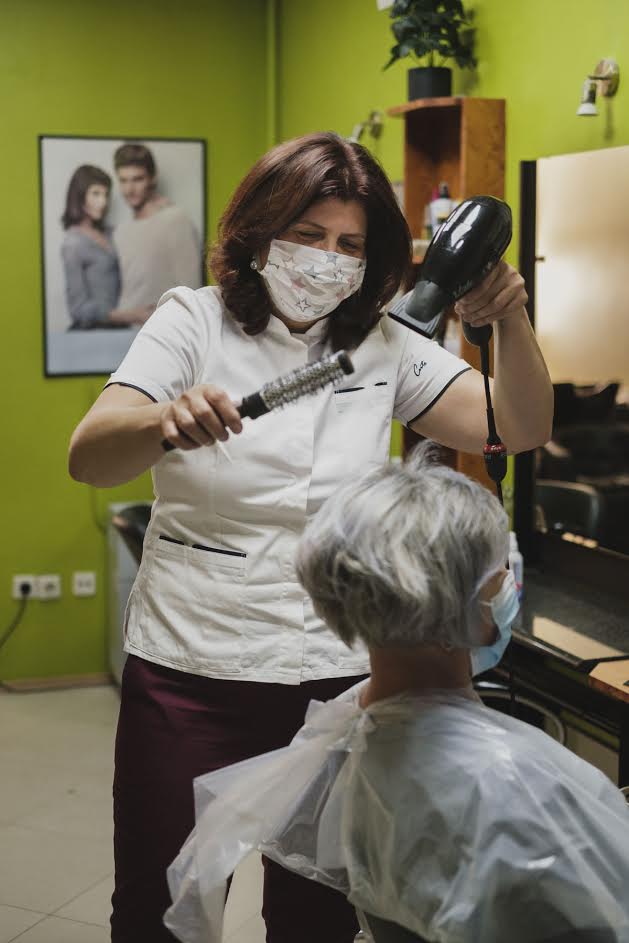
While Anita cannot employ staff to help her due to the new rules, she can take bookings. And there are a LOT.
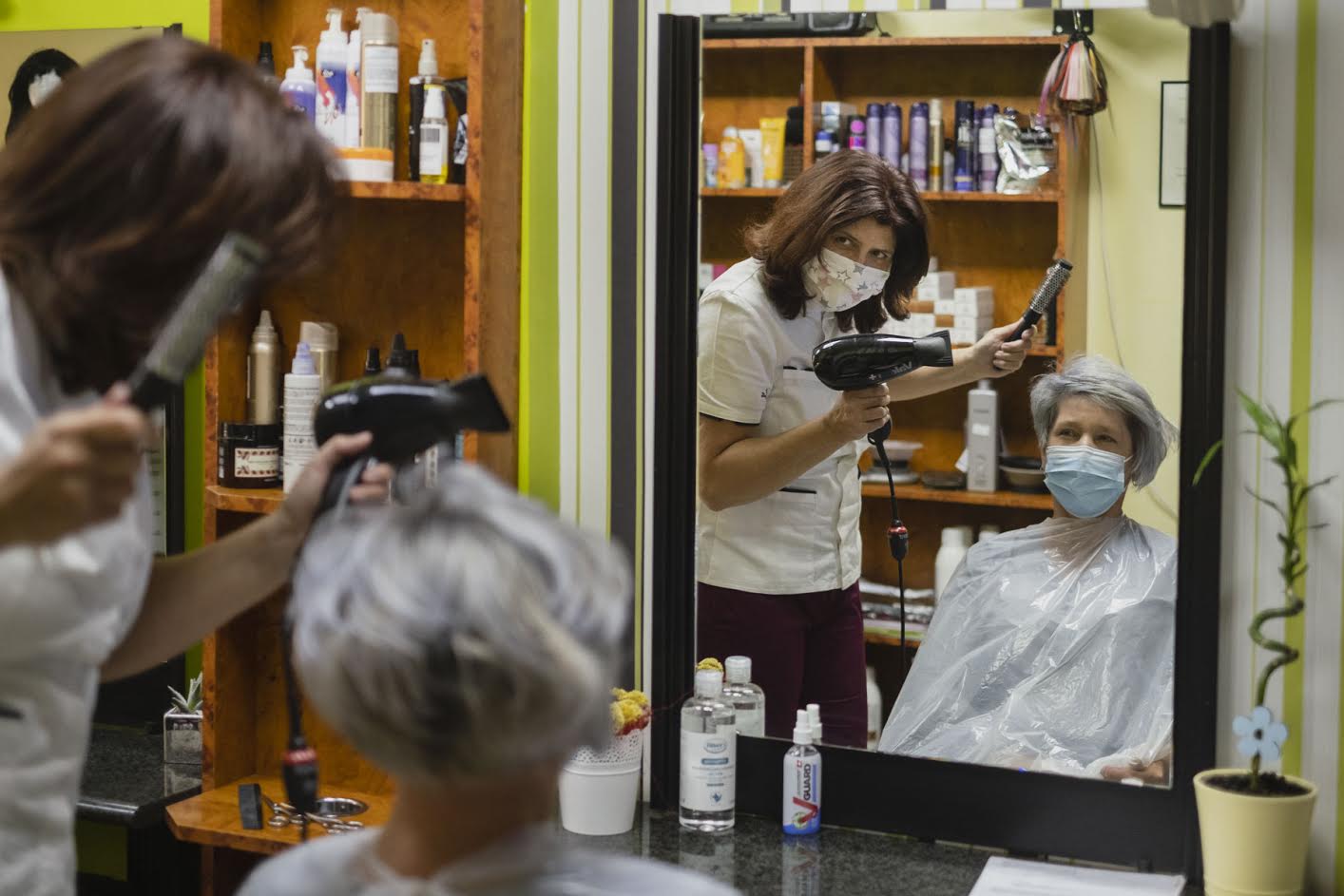
Joubert's mother-in-law called to make an appointment yesterday, and the first available date is in 3 weeks, on May 25.
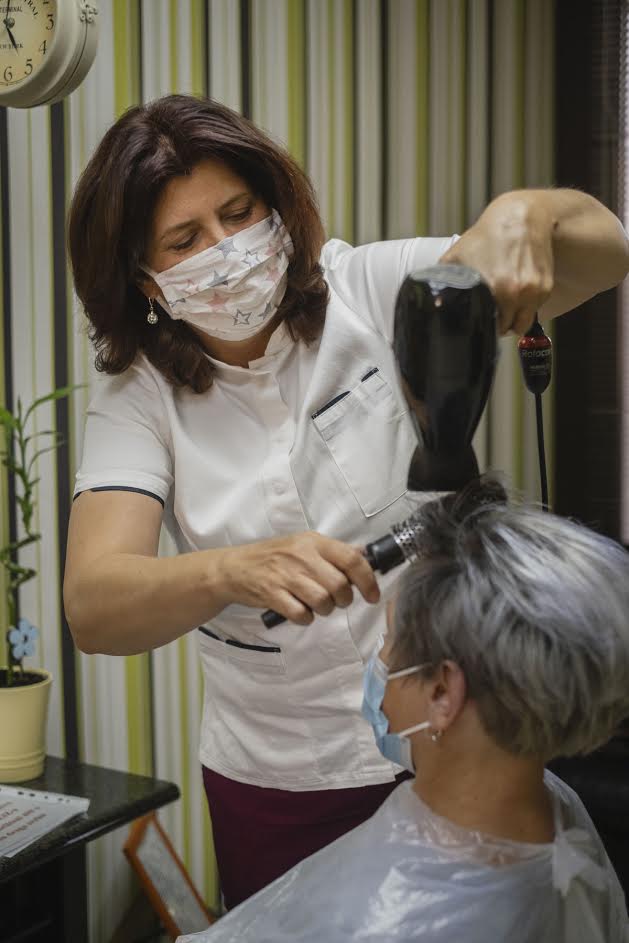
Anita is apparently fully booked for every slot until then, with an appointment every hour during her working day.
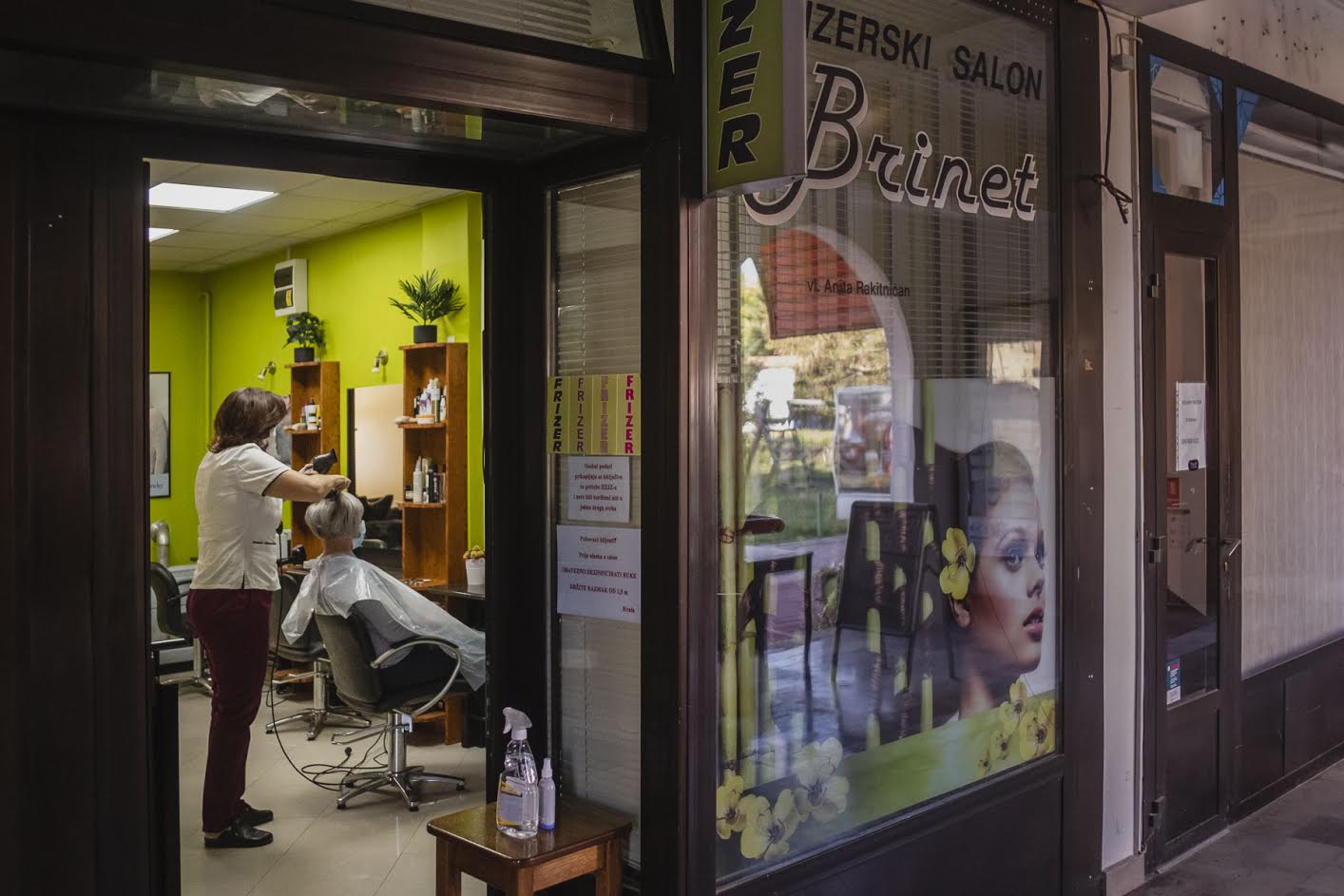
Not an ideal situation, but a small sign at least that small businesses are slowly starting again, and there is some business there.
Many thanks to Joubert for the submission. You can check out his portfolio of photography here.
Are you a small business in Croatia which has just reopened after the recent lockdown? TCN is happy to support local businesses promoting their stories. If you are interested, please send photos, your experience and your website to This email address is being protected from spambots. You need JavaScript enabled to view it. Subject Small Business.
For the latest news on COVID-19 in Croatia, follow the dedicated TCN section.
When Will Croatian Gyms Reopen? What Will Anti-Epidemic Measures Be?
As Poslovni Dnevnik/Marija Crnjak writes on the 5th of May, 2020, judging by the announcement of the Fitness Community Initiative, a group established during the coronavirus crisis to protect the rights of those in the profession and promote the importance of regular exercise, a meeting is currently being held to define the conditions for the reopening of Croatian gyms, based on proposals made by the profession.
The Initiative claims that the operations of Croatian gyms can start again as early as mid-May.
This news was published by Orlando Lopac, owner of OrlandoFit Croatia, on his Facebook profile. Lopic is otherwise one of the participants in the Initiative, which addressed the National Civil Protection Headquarters with the aim of reopening Croatian gyms and other such facilities as soon as possible. Croatian gyms employ about 20,000 people across Croatia.
As Lopac announced yesterday, a meeting will be held to develop the necessary measures and recommendations for the safe and acceptable operation of Croatian gyms and other types of sport and recreation centres, as well as defining date frameworks within which the ban on their functioning would work.
"I received a firm promise that as the Fitness Community Initiative, we'll be transparently involved in the development of these measures and recommendations, and that the basis will be the list we submitted to them. I expect that in the period between the 15th and the 18th of May, we'll be able to start working again,'' state Lopac, recommending that his colleagues in the field seriously begin developing their financial and business plans in the coming days in order to ensure maximum security in the gyms and other sport and recreation centres.
The letter sent by the Initiative to the Croatian Institute of Public Health and the Central State Office for Sport states that professional sports and recreation centres are usually and regularly characterised by a high level of hygiene, such as the changing of clothes and shoes on arrival, the use of towels, the regular disinfection of gym equipment, as well as good ventilation.
They suggest that the following measures be introduced for Croatian gyms and other such facilities:
1. The recommended (not mandatory) use of protective masks and gloves for all employees
2. The installation of dispensers with antiseptic/hand sanitisers at the entrance to each gym/facility
3. The placement of a minimum of three portable disinfectants for the gym equipment covering every 50 square metres of space
4. The recommendation of installed medical covers or specialised disinfection pads for footwear in locker rooms
5. The mandatory use of clean towels during training in order to protect the surface on which you sit, lie down or exercise or in some other way make physical contact
6. The recommendation to adhere to the rules on the number of users per unit of time indoors: 15 people per 100 square metres of space, which provides a distance of more than 2 metres, and also a maximum group of 15 participants in an open space with a minimum distance of 2 metres kept between them
7. The possibility of the unobstructed use of the locker room and shower cabins with an increased scope of disinfection of those same premises
8. The ensuring a sufficient amount of time for ventilation of the space when changing user groups
9. The prohibition of access to the premises or the training of persons who have been prescribed a self-isolation order, as well as persons with visible symptoms of illness and fever, or persons for whom there is recorded information that they are passive carriers of the coronavirus infection
10. When exercising outdoors, the disinfection of equipment and props is mandatory immediately after their use
11. The serving of hot and cold drinks should be done exclusively in disposable glasses and cups
For more on coronavirus in Croatia, follow our dedicated section.
Sudamja at Home: TZ Split and Fabrique Hosting Sv. Duje Balcony Party
May 5, 2020 - As part of the #TogetherInSplit campaign, the Split Tourist Board and Fabrique Pub are bringing a touch of the Sv. Duje tradition to your homes on May 7.
Namley, a mobile stage will be touring the Split neighborhoods where Marko Pecotic Peco and his band will sing Dalmatian hits. The Split Tourist Board wants all citizens at their windows and on their balconies to send a video message of community on Split's City Day.
"The traditional Sv. Duje feast has, for many years, awakened Split citizens in a spirit of community and belonging. Even though we are physically separated, this will be a unique postcard from Split on the day of the Sudamja celebration during the pandemic, so let's all go out to our windows, balconies and show that we are a small city with a big heart. After our collective postcard, enjoy the unique concert of Peter Graso in an empty Peristyle," said the director of the Split Tourist Board, Alijana Vukšić.
"Guided by the message of the #TogetherInSplit campaign, we wanted to thank our guests and fellow citizens for their many years of support and all the moments of fun and friendship we spent at the Fabrique pub. We have gathered our co-workers and friends, and we thank them for their engagement and for showing us that we are truly together during these difficult times. Special thanks to Marko Pecotic Peco and his band, the Apodos company for providing the panoramic bus, photographer and cameraman Ranko Pupic from Studio Smile and his valuable crew who will record reactions from your balconies, and the Split Tourist Board," said Fabrique pub.
The mobile stage will depart at 6 pm from the taxi stand near the Tourist Palace on the Riva. You can find the locations on the route below:
Bačvice- Firule taxi stand- Križine bus station - Mertojak (Elekrodalmacija)- Kila- Pujanke- Kampus- Vukovarska- Kacunar- Kman- Brda- Dubrovačka- Kazalište – Skalice- Stari plac- Krom- Lazarica- Poljud- Sv. Frane.
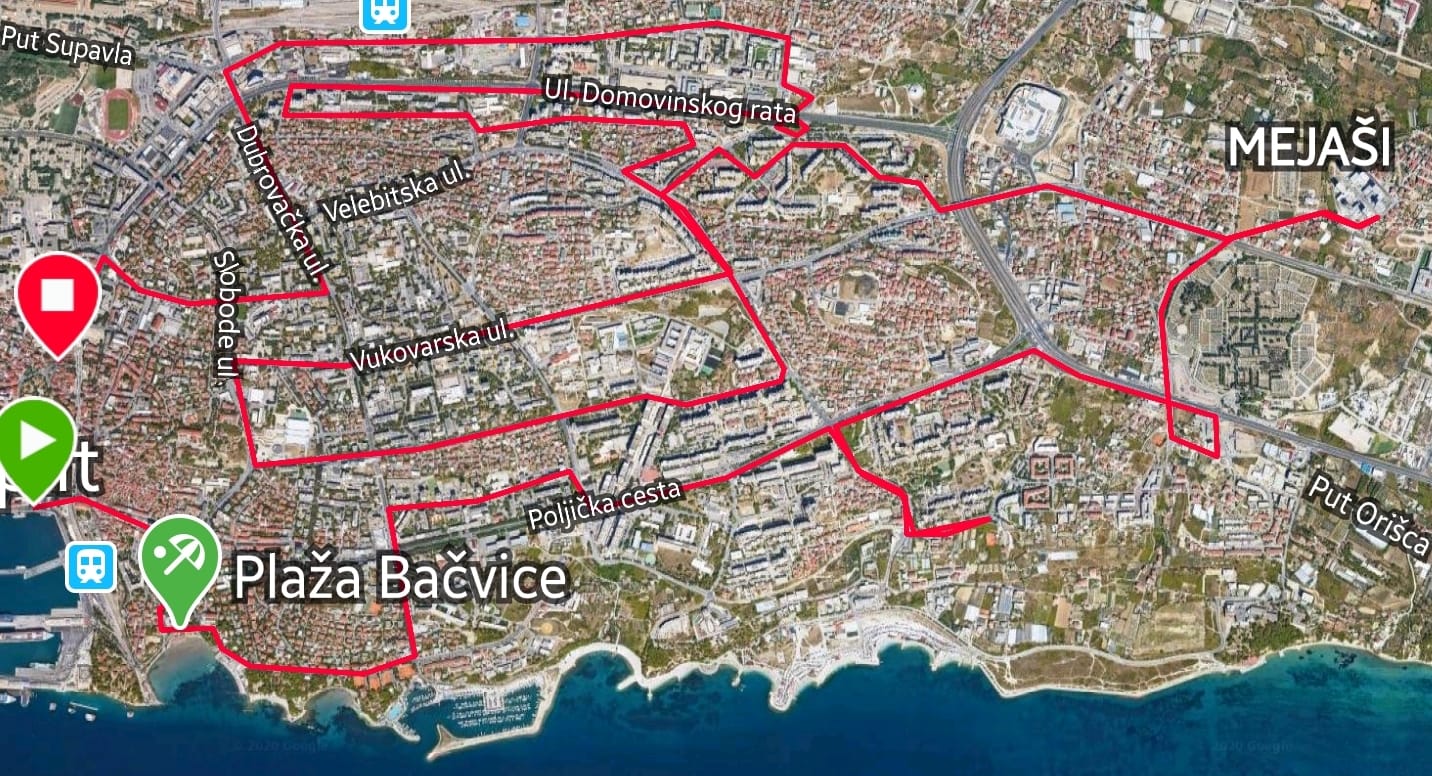
To read more about lifestyle in Croatia, follow TCN's dedicated page.
Handsome Payout for Households Damaged in Zagreb Earthquake - When?
As Poslovni Dnevnik writes on the 5th of May, 2020, the Croatian Government should finance the repair of chimneys and boilers with payouts of 20,000 kuna to every household that suffered in the devastating Zagreb earthquake just over forty days ago.
The welcome ruling announced the introduction of a special law to help with reconstruction after the Zagreb earthquake, but naturally, everyone is now wondering when that law will see the light of day.
Construction Minister Predrag Stromar also said when that could be expected.
"On March the 22nd, we immediately started drafting that law and said that we wouldn't just leave people to fend for themselves [in regard to the Zagreb earthquake]. We did everything, we know how much it will all cost. In the next week or two, we'll make all the decisions we need to make in order for the funds to be expected and as soon as the law comes into force we'll be able to start paying those funds out. It will have to be passed in the supplementary budget, we'll have to have it in our account. It will be very soon, in a week or two,'' said Predrag Stromar in an interview for RTL Danas.
He doesn't agree with the statement that we have been waiting for that law to be introduced for a long time.
"Some people have asked me why that law has been finished so quickly. The law is done, it's ready, it's in the procedure, in a few days it will go to public debate, and then from public debate to Parliament. We talked to those in the profession, there are a few different thoughts on how to solve problems. We said we'd help people and we're helping them. We have come to an agreement with everyone, with the Prime Minister, with the ministers, with those in the profession, with the chambers… So, there we go, the law is ready. I expect it in the Parliament soon, in a maximum of seven, maybe eight to ten days,'' said Stromar, adding that he expects the members of parliament to vote on the law before dissolution due to the upcoming parliamentary elections.
"This law [on the damage caused by the Zagreb earthquake] is very important to people. It's important for them to know when their homes are going to be renovated, every day [which passes] is important to them,'' said the Minister.
Commenting on the upcoming parliamentary elections, Stromar said HNS will first hold its internal party elections on May the 24th, in which it will elect a new president and a new party leadership.
"We're going to talk to smaller parties, those that have similar programme, those which are the most similar to us," Stromar said.
For more on the Zagreb earthquake, follow our lifestyle page. For more on the domestic political scene, follow our politics page.

